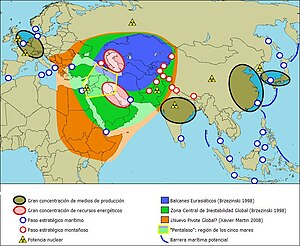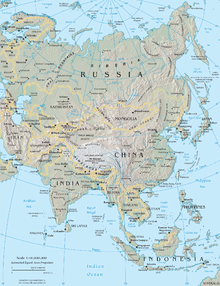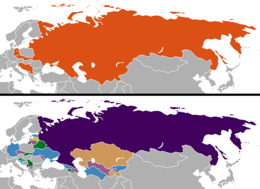Eurasian
Eurasia or Eurasia is a term that defines the geographical area on the Eurasian tectonic plate, which extends from Spain to China. This area comprises the joined continents of Europe and Asia. Given the area, it can be considered the largest landmass in the world or also a "supercontinent", as the traditional continents of Europe and Asia are actually a single unit. Furthermore, from a physiogeographical, geological and cultural point of view, Eurasia shares the Indo-European and Uralic linguistic branches in many countries and is therefore a real continent.
It is located primarily in the Northern and Eastern Hemispheres and has an area of approximately 52,990,000 km², which is equivalent to 10.6% of Earth's surface and 36.2% of Earth's area. It is inhabited by more than 5 billion people, which is equivalent to 72.5% of the world's population.
The traditional subdivision between Asia and Europe has not very precise boundaries; A dividing line is commonly defined along the Ural Mountains, the Ural River, the Caspian Sea, the Caucasus Mountains, the Black Sea, the Bosphorus Straits, the Dardanelles, and the Aegean Sea.
Karl Haushofer, a German geopolitician, proposed that this region of the world should unite socially and politically into one, in order to face maritime powers such as the United States or the United Kingdom and a better demographic-social-economic distribution, although these ideas were not put into practice.
Geology
Eurasia sits mainly on the Eurasian plate. According to recent geological history, it originates as a continent at the beginning of the Cenozoic, 60-55 million years ago, when the supercontinent Laurasia split between Eurasia and North America, opening up the Atlantic. Subsequently, the Indian subcontinent joins when colliding with the supercontinent forming South Asia 35 million years ago and in the Oligocene Arabia separates from Africa when the Red Sea opens, joining the continent.
Anthropology
Anthropologically, Eurasia can be appropriately divided into West Eurasia (often including North Africa) and East Eurasia, and these in turn further subdivided into regions, such as Europe, Near East, Central Asia, East Asia, South Asia, Southeast Asian and Siberian, which have cultural, religious, historical and linguistic differences.
The consideration of Eurasia as a continent is relative, since Euraphrasia could also be used, which would also contain Africa. The belief that Eurasia should be called as a single continent clashes with the idea that Oceania is a continent since they are only islands, and defining based on tectonic plates is also relative since there are more than ten of them.
Use of the term
History of the Europe-Asia division
In ancient times, the Greeks classified Europe (derived from the mythological Phoenician princess) and Asia which to the Greeks originally included Africa (derived from Asia, a woman in Greek mythology) as "lands" separated. Where to draw the dividing line between the two regions remains a matter of debate. It is especially disputed whether the Kuma-Manych Depression or the Caucasus Mountains form the southeastern boundary, since Mount Elbrus would form part of Europe in the latter case, making it (and not Mont Blanc) the highest mountain in Europe. The most widely accepted is probably the limit defined by Philip Johan von Strahlenberg in the 18th century. He defined the dividing line along the Aegean Sea, the Dardanelles, the Sea of Marmara, the Bosporus, the Black Sea, the Kuma-Manych Depression, the Caspian Sea, the Ural River, and the Ural Mountains. However, at least part of this definition has been criticized by many modern analytical geographers such as Halford Mackinder, who saw little validity in the Ural Mountains as a boundary between continents.
Geography
In modern usage, the term "Eurasian" is a demonym usually meaning "of or relating to Eurasia" or "a native or inhabitant of Eurasia". Also used to describe people of mixed "Asian" and "European".
Located primarily in the eastern and northern hemispheres, Eurasia is considered a supercontinent, part of the Afro-Eurasia supercontinent, or simply a continent in its own right. In plate tectonics, the Eurasian plate includes Europe and most of of Asia, but not the Indian subcontinent, the Arabian peninsula, or the area of the Russian Far East east of the Chersky Range.
From the point of view of history and culture, Eurasia can be loosely subdivided into Western Eurasia and Eastern Eurasia.
Soviet states after decentralization
19th century Russian philosopher Nikolai Danilevsky defined Eurasia as a separate entity from Europe and Asia, bounded by the Himalayas., the Caucasus, the Alps, the Arctic, the Pacific, the Atlantic, the Mediterranean, the Black Sea, and the Caspian Sea, a definition that has been influential in Russia and other parts of the former Soviet Union. Today, inspired Partly because of this usage, the term Eurasia is sometimes used to refer to the post-Soviet space—particularly Russia, the Central Asian republics, and the Transcaucasus republics—and sometimes also to adjacent regions such as Turkey and Mongolia.
The word "Eurasia" is often used in Kazakhstan to describe its location. Many Kazakh institutions bear the term in their names, such as the L. N. Gumilev Eurasian National University (in Kazakh, Л. Н. Гумилёв атындағы Еуразия Ұлтық университеті; in Russian, Евразийский Национальный университет имени Л. Н. Гумилёва) (Lev Gumilev's ideas of Eurasianism having been popularized in Kazakhstan by Olzhas Suleimenov), the Eurasia Media Forum, Media the Eurasian Cultural Foundation (in Russian, Евразийский фонд культуры), the Eurasian Development Bank (in Russian, Евразийский банк развития), and the Eurasian Bank. to connect the Caspian and Black Seas through Russia's Kuma-Manych Depression to provide Kazakhstan and other Caspian Basin countries with a more efficient pathway to the ocean than the current Volga-Don Canal.
This usage can also be seen in the names of Eurasianet, The Journal of Eurasian Studies, and the Association for Slavic, East European, and Eurasian Studies, as well as the titles of numerous academic programs at American universities.
This usage is comparable to the way Americans use "Western Hemisphere" to describe concepts and organizations dealing with the Americas (for example, Council on Hemispheric Affairs, Western Hemisphere Institute for Security Cooperation).
Geopolitics
Originally, "Eurasia" it is a geographical notion: in this sense, it is simply the largest continent; the combined land mass of Europe and Asia. However, from a geopolitical point of view, the word has several meanings, reflecting specific geopolitical interests. "Eurasia" it is one of the most important geopolitical concepts and occupies a prominent place in the commentaries on the ideas of Halford Mackinder. As Zbigniew Brzezinski observed of Eurasia:
! "... the way the United States manages Eurasia is fundamental. A power that dominates "Eurasia" would control two of the three most advanced and economically productive regions in the world. A simple look at the map also suggests that control of "Eurasia" would almost automatically involve subordination of Africa, making the Western hemisphere and Oceania geopolitically peripheral to the central continent of the world. About 75% of the world's population lives in "Eurasia", and most of the world's physical wealth is also there, both in its companies and under its soil. "Eurasia" represents about three quarters of the world's known energy resources"
"Eurasianism" Russia initially corresponded roughly to the land area of Imperial Russia in 1914, including parts of Eastern Europe. One of Russia's main geopolitical interests lies in ever closer integration with those countries it considers part of "Eurasian. " This concept is further integrated with communist eschatology by author Alexander Dugin as the guiding principle of "self-sufficiency of a large space" during expansion.
The term Eurasia gained a reputation for geopolitics as one of three superstates in George Orwell's 1984 novel where constant surveillance and propaganda they are strategic elements (introduced as reflexive antagonists) of the heterogeneous device in metapolitical constructions used to control and exercise power.
References to Eurasia in literature, film, music and video games
- Eurasia is also one of the transcontinental antagonistic nationalities in the continuous but always diffuse wars of the novel 1984 George Orwell.
- Eurasia is the name of a space colony in the Mega Man X video game series.
- In the game of SNES Terranigma, the main character of the series has to be reborn on five continents, whose names are Eurasia, North America, South America, Africa and Australia, referring analogously to our five continents.
- "United States of Eurasia" is the title that carries a song from the British band Muse, included in his album The Resistancein which he refers to the United States attempting to annex Eurasia in order to maintain its hegemony, referring to the United States of Eurasia of George Orwell's novel 1984. In this novel by George Orwell, Eurasia comprises approximately the Soviet Union and Europe except the British and Icelandic Islands, which are controlled by the second country, Oceania, comprising the United States, Australia, New Zealand and southern Africa. The third fictitious country is Esteia (East Asia) formed by China, Japan and Korea. India, for its part, is a border area disputed between Eurasia and Oceania.
- Eurasia is the title of the last CD in study of the German power metal band Avalon.
Contenido relacionado
Gaul
Abuja
Demographics of Argentina



